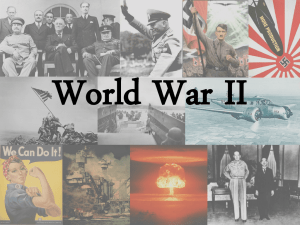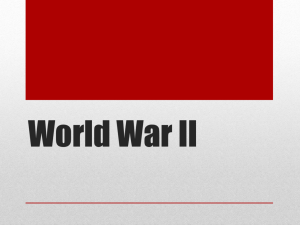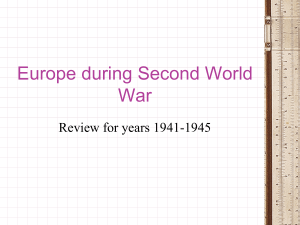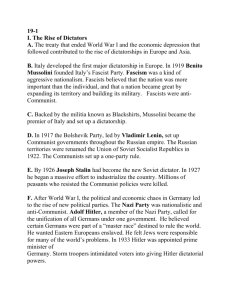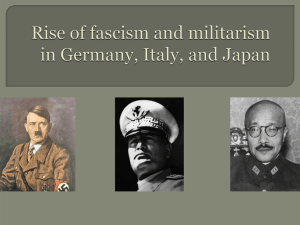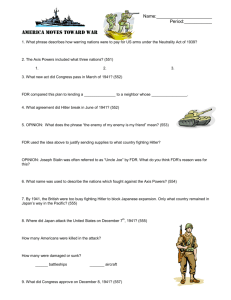The Coming of World War II Notes Chapter 25 Section 1
advertisement
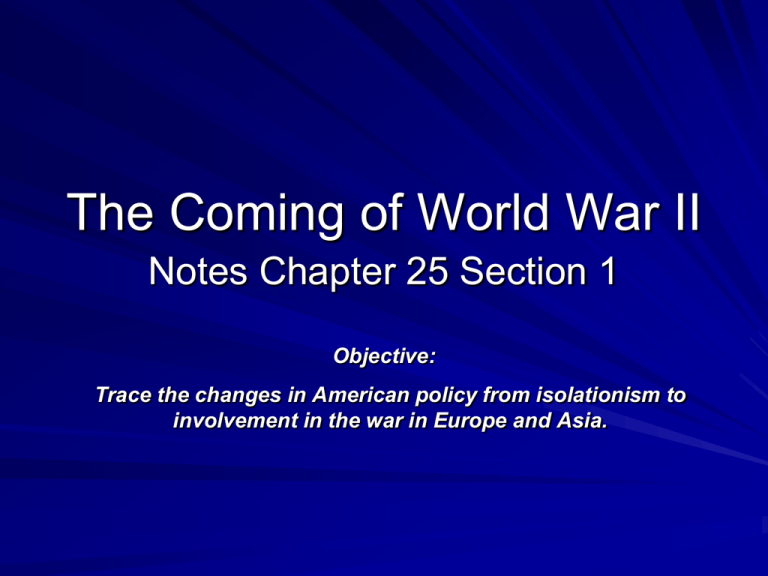
The Coming of World War II Notes Chapter 25 Section 1 Objective: Trace the changes in American policy from isolationism to involvement in the war in Europe and Asia. Rise of Dictators Rise of dictatorships during 1920s in Germany, Italy, and Japan • Fascism: -totalitarian organization of government and society by a single-party dictatorship, intensely nationalist, racist, militarist, and imperialist Fascism Fasces A Latin word referring to a bundle of sticks bound to the handle of an axe. Characteristics Fascism … Censorship No criticism of the government Schools teach fascist philosophy No individual freedom Characteristics Fascism … Private ownership Fascist powers look back in history to their nation’s great and glorious past. “War is the most noble goal of man”- Hitler Communism v. Fascism Poor and underdeveloped countries – Russia and China Pre-democratic Coercive way of industrializing an underdeveloped society Wealthier and advanced technology – German, Italy, and Japan Post-democratic Based on brutality and mass support – the more brutal, the more popular Propaganda Appealed to: industrialists and land owners and lower middle class Opposed communism Italy – Benito Mussolini Short changed in Treaty of Versailles – gained few territories 1919 formed Fascist party with other veterans Wanted to restore the former glory that was Rome’s Mussolini – Il Duce 1922 threatened to march on Rome unless his authority was recognized King Victor Emmanuel III asked him to become prime minister 1925 declared dictatorship – Efficiency and order would make Italy great – Suspended elections – Centralized the economy – Modernized the military – Make the Mediterranean an Italian Sea – Attacked Ethiopia in 1935 Hitler Corporal in WWI Enraged at Germany’s defeat and terms of Versailles Treaty National Socialist German Workers Party – Nazi Fascist Anti-Semite Munich Putsche November 1923 Attempted to seize Munich government Guilty of high treason Sentenced to 5 years Served 9 months Wrote Mein Kampf Mein Kampf Book written while Hitler was jailed Diagnosed Germany’s problems and how to cure them Expressed hatred for the Jews and Slavic people Hatred for communism Said Germany needed Lebensraum Anti-Semitism Hatred of the Jews Blamed Jews for Germany’s problems Germans were the Master Race Ordered boycott of Jewish shops, burned books, imprisoned Jews in concentration camps Conditions in Germany People had little faith in the weak existing democratic government A multi-party system hindered the growth of a strong “center” party Fear of communism Avenge defeat of WWI Unemployment severe, inflation, depression German middle class hungered for stability – even at the cost of liberty Police and military high command offered no serious opposition when Nazis used strong-arm methods to gain control Rise to Power 1920 – National Socialist Workers Party 1923 – Tried to seize Munichjailed for 9 months Promised to stabilize country and rebuild economy Promised to revive German Empire 1933 – Nazis largest party in Reichstag Hitler named chancellor Hitler Seizes Power Reichstag burns down Hitler suspended civil liberties Received dictatorial powers New government – Third Reich Der Fuhrer “How fortunate for leaders that men do not think.” - A. Hitler Book burning - May 10, 1933 Hitler Repudiates the Treaty of Versailles 1. Insisted on equality of arms 2. Announced withdrawal from League of Nations 3. 1935 – announced rearmament of Germany The Nuremberg Rally German Propaganda Posters "Hitler is building. Help him. Buy German goods." Hitler strengthens his power… 1933: Concentration camps 1935: The Nuremberg Laws… 1938: Kristallnacht – “The Night of Broken Glass”… The Nuremberg Laws Nazi Racial Legislation Laws designed to… - Purify Germany - Define citizenship - Define the position of Jews in the Third Reich. The Nuremberg Laws Nazi Racial Legislation A few examples 1933-1939: suspends Jewish doctors from the city’s charity services. removes Jews from government service. The Gun Law excludes Jewish gun merchants. invalidates all German passports held by Jews. – Jews must surrender their old passports, which will become valid only after the letter “J” had been stamped on them. Exclusion of Jews from German Economic Life closes all Jewishowned businesses. expels all Jewish children from public schools. restricts the freedom of movement of Jews. Jim Crow Laws US Racial Legislation A few examples: Nurses No person or corporation shall require any white female nurse to nurse in wards or rooms in hospitals, either public or private, in which negro men are placed. Alabama Education The schools for white children and the schools for negro children shall be conducted separately. Florida Intermarriage It shall be unlawful for a white person to marry anyone except a white person. Any marriage in violation of this section shall be void. Georgia Textbooks Books shall not be interchangeable between the white and colored schools, but shall continue to be used by the race first using them. North Carolina Lunch Counters No persons, firms, or corporations, who or which furnish meals to passengers at station restaurants or station eating houses, in times limited by common carriers of said passengers, shall furnish said meals to white and colored passengers in the same room, or at the same table, or at the same counter. South Carolina 1938: Kristallnacht "Night of Broken Glass" Jewish teenager murders a German official in Paris Violent pogrom (persecution) against Germany’s Jews Initiated on the 15th anniversary of the failed Munich putsch. 1,000 synagogues burned & 7,000 Jewish businesses looted Jewish cemeteries, hospitals, schools & homes looted 30,000 arrested for “being Jewish” Jewish business not allowed to reopen Curfews on Jews leaving their homes 1931-32 World Events: Japan invades Manchuria & Shanghai American Response: Diplomatic protest No Action Japan Wanted to be a world power Chain of islands in Pacific Limited resources Japan needed raw materials for industrial economy Depended upon the U.S. for iron, coal, and petroleum Japanese Resentment Material dependency Lack of gains from Treaty of Versailles 1922 Washington Naval Disarmament Treaty Restrictions on immigration to US High U.S. tariffs prohibited Japanese imports to U.S. Led to prolonged depression in Japan Two factions in Japan Moderates – wanted strict observance of treaties and conciliations to U.S. Militarists – wanted an end to the power of the West in the W. Pacific Greater Asian Co-Prosperity Sphere Japanese Monroe Doctrine Japan announces interest in maintenance of order in the W. Pacific 1931 Japan attacked Manchuria 1932 Japan controlled Manchuria – – – – Set up a puppet government Manchukuo League of Nations condemned Japanese aggression Japan withdraws from the League 1935 World Event: Italy invades Ethiopia American Response: The Neutrality Acts are passed Italo – Ethiopian War 1935-36 Italy attacked primitive Ethiopia with a modern air force Emperor Haille Salasi appealed to the L of N Italy & Ethiopia 1935 Italy invades the African nation of Ethiopia More empty threats by League 1936 Ethiopia falls League branded Italy the aggressor –Minor economic sanctions –Failed to embargo oil –Italy conquered and annexed Ethiopia American Response Isolationism Disillusioned by WWI – 70% polled feel WWI a mistake – Nye Committee “merchants of death” College students – 39% refuse to fight – 33% only if US attacked – Nationwide student strike opposing war prep Spans political spectrum – Keep America Out - unionists – America First Committee – Henry Ford – Charles Lindbergh – denounced any move by the gov’t toward involvement The Neutrality Acts Designed to keep the US out of war… – 1935: Banned war supplies – 1935: Forbid travel – 1936: Prohibited loans – 1937: Included the Spanish CW – 1939: “cash-and-carry”… – Replaced by “lend-lease” … Neutrality Acts Designed to avoid the same issues that caused U.S. to enter WWI 1st Neutrality Act – Prohibited sale of war implements to belligerents – Prohibited loans to belligerents – Prohibited Am. from sailing on ships of belligerents – Restricted entry of U.S. merchant ships into war zones 1936 World Event: Germany rearms & sends troops into the Rhineland American Response: Britain, France & U.S. No action 1936 The Axis Powers Germany - Italy Rome-Berlin Axis Supporting “parallel interests” The Axis Powers Axis- a straight line around which a geometric figure can rotate. Draw a line between Rome & Berlin… The two dictators wanted the rest of Europe to revolve around their regimes. Guernica, Picasso 1937 1936 World Event: Civil War in Spain General Francisco Franco American Response: Neutrality Acts amended Spanish Civil War 1936-37 Rebels – army, Churchmen, fascists – Franco and Nationalist forces Gov’t of Spain (The Republic): anticlericals, industrial workers, socialists, and communists, foreign volunteers Italy and Germany sent “volunteers” to help the Nationalist Franco rules from 1939 until his death in 1975 Spanish Civil War 27 nations involved England and France embargoed arms to both sides because of danger of world war Majority of Am. refused to take sides Minority of Am. supported loyalists – Abraham Lincoln Brigade U.S. invoked neutrality laws and refused to sell arms Dress rehearsal for WWII “This nation will remain a neutral nation… I hate war… I hope the United States will keep out of this war. I believe this is wise.” - President Roosevelt Fireside Chat, Aug. 14,1936 1937 World Event: Japan begins full scale invasion of China * WW II officially starts in Asia American Response: Diplomatic protest Congress appropriates $1 billion to expand the navy Japanese aggression 1937 – Invasion of Northern China Captures Nanjing and slaughters 300,000 Chinese civilians Believe America is weak – Neutral position on Manchurian Crisis – Steps toward Philippine independence – Efforts toward American Naval disarmament Undeclared War July, 1937 – an “undeclared” war on China Americans are sympathetic and do not invoke neutrality laws FDR – Quarantine Speech – denounced aggressor nations and asked peace-loving nations to preserve order, as “a community approves and joins in quarantine” against disease 1938 World Events: Germany annexes Austria (Anschluss) & Sudetenland The Munich Pact is signed Munich Conference 1938 Great Britain and France met with Hitler Hitler promises Sudetenland “last territorial claim” PM Chamberlain of G.B. said: “We have won peace in our time.” **Appeasement** Keeps the peace by giving in to Hitler’s demands Emboldens Hitler The Munich Pact 1939 World Event: • Germany invades Czechoslovakia • Stalin & Hitler sign a Non-Aggression Pact • Hitler invades Poland from the west • Stalin invades from the east – – – – – Poland Estonia Latvia Lithuania Finland Blitzkrieg (lightning war) • • Germany attacks Poland – Sept. 1, 1939 G.B. and France declare war against Germany – Sept. 3, 1939. 1939 American Response: The Neutrality Acts are amended to “cash & carry” 1940 World Event: • Germany invades Denmark, Norway, Holland, Belgium & France WW II officially starts in Europe Blitzkrieg… – Dunkirk… – The Battle for Britain… 1940 American Response: • • • Selective Service Act… Destroyers for Bases Deal… Lend-Lease Plan… Arsenal of Democracy Roosevelt moved to help Great Britain – PM Winston Churchill asked for destroyers to convoy supplies across the Atlantic FDR gave 50 old American ships in return for sites on which to build 8 naval and air bases Lend – lease: The U.S. will lend-lease goods to any country whose defense is necessary for the defense of U.S. Fall of France Maginot Line Germans invade through the Ardennes Forest Italy declares war against France Evacuation “Miracle at Dunkirk” – 338,000 British soldiers saved Fall of Paris Occupied France – German occupied north and west – disarmed – Vichy France – Marshall Petain – collaborationist regime Free French led by Charles de Gaulle escapes to GB The Axis Powers Germany - Italy - Japan 1940 – Tripartite Pact Rome – Berlin –Tokyo Axis Japan sought control of SE Asia 1940 –began to attack European possessions in SE Asia 1940 – signed an alliance with Germany and Italy 1941 – invaded southern IndoChina – a colony of France Election of 1940 Democrats “drafted” FDR – Henry Wallace was his running mate Wendell Wilkie nominated by the Republicans Issues: – Third term – Intervention FDR won an unprecedented third term 1941 World Event: German invasion of the USSR Operation Barbarossa… Battle of Britain Round the clock bombing Ultra and the development of radar Role of RAF Operation “Sea Lion” - Postponed We shall defend our Island, whatever the cost may be. We shall fight on the beaches, we shall fight on the landing grounds, we shall fight in the fields, and in the streets, we shall fight on the hills; we shall never surrender …W. Churchill Atlantic Charter (1941) Roosevelt and Churchill identify “common principles” – Freedom from fear, want, and tyranny – Condemned aggression – Free trade – Affirmed national selfdetermination – Disarmament – Collective security – Foundation for UN Undeclared War in the Atlantic Germans cut off England “wolf – packs” hunt Am. supply ships – September, 1941 – US destroyer Greer attacked – Oct. 31 – destroyer Reuben James sunk with 115 crew members Summer 1941 10,000 tons of Allied ships sank daily FDR ordered US ships to shoot German subs on sight – Ordered our merchant ships to be armed – U.S. began to convoy ships 1941 American Response: FDR: The Four Freedoms Speech… Freedom From Fear Freedom From Want Freedom of Speech Freedom of Worship Sunday morning, Dec. 7, 1941 Pearl Harbor Tension between U.S. and Japan: 1940 – the U.S. stopped selling airplanes to Japan – terminated trade agreementsembargoed scrap metal and oil to Japan Japan attacked French Indo-China – U.S. froze Japanese assets in U.S. U.S. naval fleet in Pearl Harbor stood in the way of Japanese dominance in Asia and Pacific Pearl Harbor Pearl Harbor – Ford Island The Attack Knock out the Pacific fleet before and all-out military conflict Dec. 7, 1941 Lost: 5 battleships, 3 cruisers, several smaller vessels, 200 airplanes, 2,400 people Missed: Aircraft carriers Dec. 8 – U.S. declared war on Japan Germany and Italy declared war on the U.S. The Pearl Harbor attack… The largest surprise attack in history 353 planes… Launched from 274 miles away Two waves: 1st : 7:53 AM -183 planes 2nd: 8:40 AM -170 planes Pearl Harbor The damages… 2,400 dead 1,200 wounded 8 battleships 3 destroyers 3 cruisers 188 planes Japanese photo of the Pearl Harbor attack… USS SHAW USS ARIZONA Battleships USS WEST VIRGINIA & USS TENNESSEE USS CALIFORNIA USS CALIFORNIA USS WEST VIRGINIA (left) & USS ARIZONA (right) USS OKLAHOMA USS NEVADA beached P-40 - WHEELER ARMY AIR FIELD Destroyers USS CASSIN & USS DOWNES WHEELER ARMY AIR FIELD B-17- HICKAM ARMY AIR BASE Map of the Axis Powers 1942 “I fear that all we have done is awaken a sleeping giant, and fill him with a terrible resolve." - General Yamato of the Imperial Japanese Navy FDR requests a declaration of war… Pearl Harbor "Yesterday, Dec. 7, 1941 - a date which will live in infamy the United States of America was suddenly and deliberately attacked by naval and air forces of the Empire of Japan." -Franklin Roosevelt, December 8, 1941 "...Every single man, woman, and child is partner in the most tremendous undertaking of our history." FDR A Global War Dec. 11 1941 Germany & Italy declare war on the U.S. Hitler declares war against the “half Judaized and the other half Negrified” America The U.S. acknowledges a state of war Aerial photo USS Arizona Memorial

